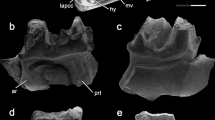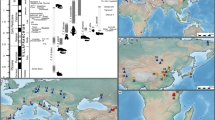Abstract
THE first description to reach Europe of a member of the kangaroo family is generally held to be that of the Dutchman Pelsaert in 16291. He described from Western Australia an animal like a civet cat with short fore-legs and long hind-legs the young of which grew out of a pouch attached to nipples. This has been identified as one of the scrub wallabies, Protemnodon (Thylogale) eugenii1,2.
This is a preview of subscription content, access via your institution
Access options
Subscribe to this journal
Receive 51 print issues and online access
$199.00 per year
only $3.90 per issue
Buy this article
- Purchase on Springer Link
- Instant access to full article PDF
Prices may be subject to local taxes which are calculated during checkout
Similar content being viewed by others
References
Troughton, E., The Furred Animals of Australia (Sydney, 1947).
Tate, G. H. H., Bull. Amer. Mus. Nat. Hist., 91, 237 (1948).
Stevens, H. N., and Barwick, G. F., Hakluyt Soc., second ser., 64, (1930).
Tate, G. H. H., Bull. Amer. Mus. Nat. Hist., 97, 189 (1951).
Laurie, E. M. O., and Hill, J. E., List of Land Mammals of New Guinea, Celebes and Adjacent Isles (London, 1954).
Bayldon, F. J., J. Roy. Austral. Hist. Soc., 11, 158 (1925).
Sharp, A., The Discovery of Australia (Oxford, 1963).
Author information
Authors and Affiliations
Rights and permissions
About this article
Cite this article
GEORGE, W. An Early European Description of an Australasian Mammal. Nature 202, 1130–1131 (1964). https://doi.org/10.1038/2021130a0
Issue Date:
DOI: https://doi.org/10.1038/2021130a0
This article is cited by
-
Early European Description of an Australian Mammal
Nature (1965)
-
Early European Description of an Australian Mammal
Nature (1965)
Comments
By submitting a comment you agree to abide by our Terms and Community Guidelines. If you find something abusive or that does not comply with our terms or guidelines please flag it as inappropriate.



